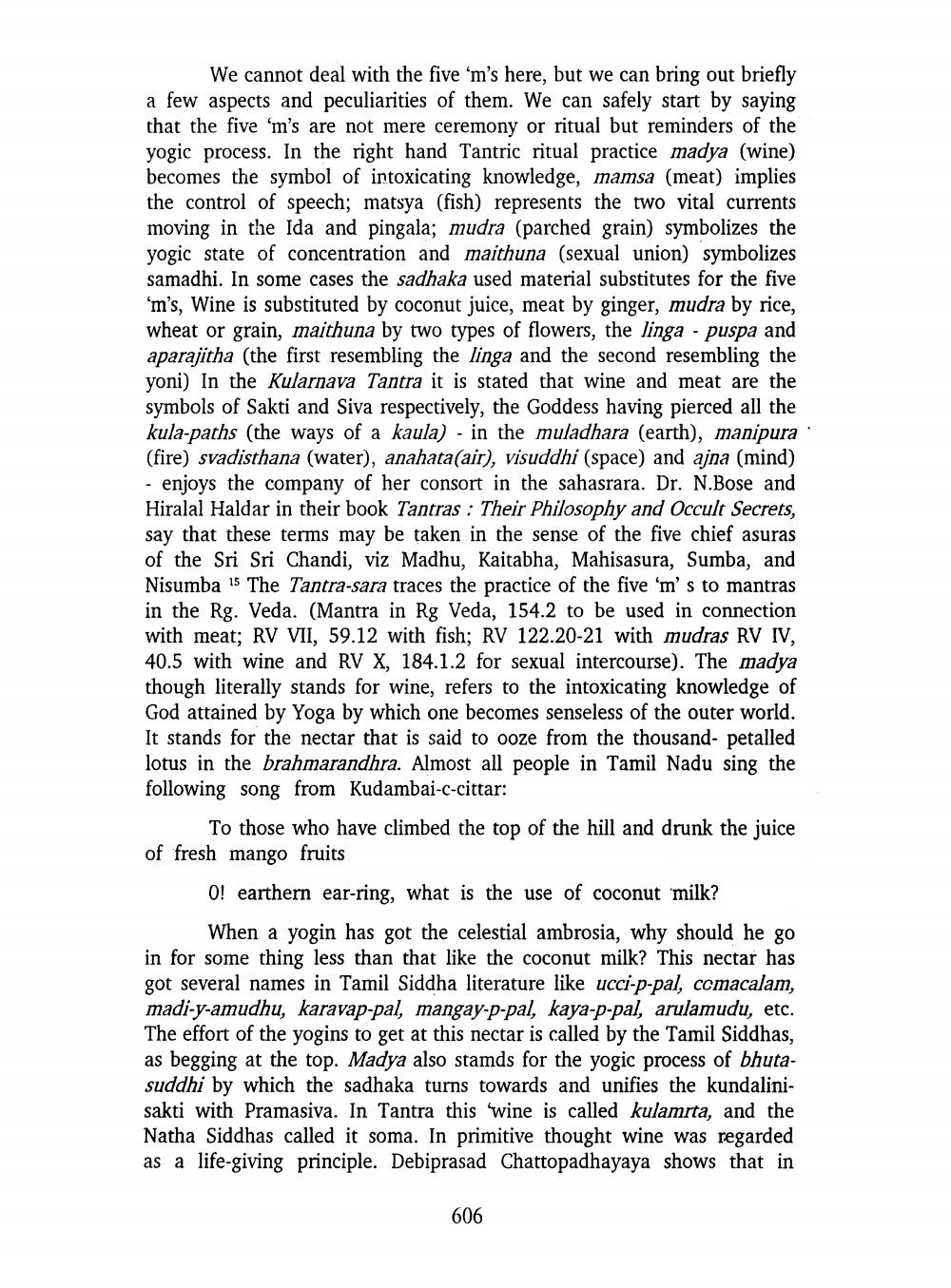________________
We cannot deal with the five ‘m's here, but we can bring out briefly a few aspects and peculiarities of them. We can safely start by saying that the five 'm's are not mere ceremony or ritual but reminders of the yogic process. In the right hand Tantric ritual practice madya (wine) becomes the symbol of intoxicating knowledge, mamsa (meat) implies the control of speech; matsya (fish) represents the two vital currents moving in the Ida and pingala; mudra (parched grain) symbolizes the yogic state of concentration and maithuna (sexual union) symbolizes samadhi. In some cases the sadhaka used material substitutes for the five 'm's, Wine is substituted by coconut juice, meat by ginger, mudra by rice, wheat or grain, maithuna by two types of flowers, the linga - puspa and aparajitha (the first resembling the linga and the second resembling the yoni) In the Kularnava Tantra it is stated that wine and meat are the symbols of Sakti and Siva respectively, the Goddess having pierced all the kula-paths (the ways of a kaula) - in the muladhara (earth), manipura (fire) svadisthana (water), anahata(air), visuddhi (space) and ajna (mind) - enjoys the company of her consort in the sahasrara. Dr. N.Bose and Hiralal Haldar in their book Tantras : Their Philosophy and Occult Secrets, say that these terms may be taken in the sense of the five chief asuras of the Sri Sri Chandi, viz Madhu, Kaitabha, Mahisasura, Sumba, and Nisumba 15 The Tantra-sara traces the practice of the five 'm's to mantras in the Rg. Veda. (Mantra in Rg Veda, 154.2 to be used in connection with meat; RV VII, 59.12 with fish; RV 122.20-21 with mudras RV IV, 40.5 with wine and RV X, 184.1.2 for sexual intercourse). The madya though literally stands for wine, refers to the intoxicating knowledge of God attained by Yoga by which one becomes senseless of the outer world. It stands for the nectar that is said to ooze from the thousand- petalled lotus in the brahmarandhra. Almost all people in Tamil Nadu sing the following song from Kudambai-c-cittar:
To those who have climbed the top of the hill and drunk the juice of fresh mango fruits
0! earthern ear-ring, what is the use of coconut milk?
When a yogin has got the celestial ambrosia, why should he go in for some thing less than that like the coconut milk? This nectar has got several names in Tamil Siddha literature like ucci-p-pal, ccmacalam, madi-y-amudhu, karavap-pal, mangay-p-pal, kaya-p-pal, arulamudu, etc. The effort of the yogins to get at this nectar is called by the Tamil Siddhas, as begging at the top. Madya also stamds for the yogic process of bhutasuddhi by which the sadhaka turns towards and unifies the kundalinisakti with Pramasiva. In Tantra this wine is called kulamrta, and the Natha Siddhas called it soma. In primitive thought wine was regarded as a life-giving principle. Debiprasad Chattopadhayaya shows that in
606




